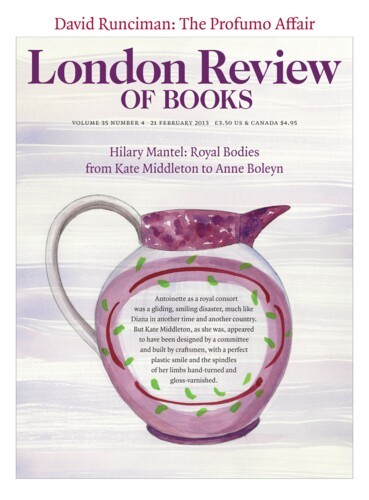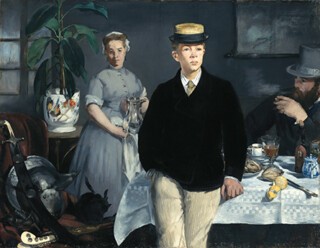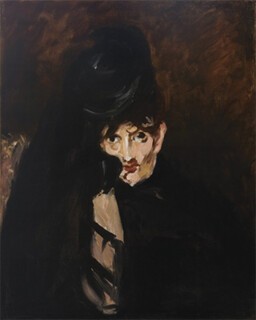‘The Luncheon’, a canvas three feet nine inches high and five feet wide, dominates the opening gallery of the Royal Academy’s exhibition Manet: Portraying Life (until 14 April). In a sense it dominates the whole show, since the deep charcoal grey in which all the RA’s first-floor galleries have been painted takes its cue from the painting’s background hue. Spotlights, not daylight, illuminate them: you might be in some freaky nightclub, except that the grey gets recast as brightness by the extraordinary block of black springing out at you from just off centre in The Luncheon. Around this magnetic weight, which represents a pea coat, there cluster various off-whites: a striped collar, a youth’s pale cheeks, his boater and his summer trousers, plus the chequered damask covering the dining table he’s leaning against, and a flowerpot in the dim room behind. Attune your eyes to that room, and two figures slot into place either side of the pea coat, a bearded male sat puffing at a cheroot and a serving maid set in quotes: that’s to say, archly summarised, like a gag too weary to need a punchline; secondhand, pre-looked.
The Luncheon’s whimsical teasing (why that antique armour joining the cat on the spare chair?) flips over into a mesmeric fullness – ah, the sheen on that damask, the fat of the boy’s cheeks! (The boy is Léon Leenhoff, the son of Manet’s wife.) And then, elsewhere in the show, its brilliant black becomes a conduit for anxiety. In 1874, six years on from The Luncheon, a glowering Berthe Morisot sat once more for Manet, after many previous encounters: this time, in mourning for her father. The complexity of the challenge – the authority of her grief compounding the artistic and sexual authority that comes through in Manet’s earlier responses to her presence – cornered him into a frantic attack on his two-foot-high canvas, stabs and swipes of black pelting down on two other mainstays of his palette, a bright flesh tint and a cow-dung brown. Everything became ragged, snatched, hollow.
MaryAnne Stevens, the curator, wants to take Manet on via the genre of the portrait. It seems a backdoor approach. Portrait commissions mattered to Manet in the decade before his death, aged 51, in 1883, but throughout his formative years this moneyed Parisian could afford to set genres in quotes: they were second-order considerations for his practice. The aspect of The Luncheon that makes it a portrait, and likewise, the bid it seems to make to be a masterpiece, come across as mere functions of a larger playfulness. Even so, the distance separating The Luncheon from Berthe Morisot in Mourning helps set the co-ordinates of the genre. At one end, you could posit, a portrait might deliver a statement. It might claim, through a fat firm set of marks, to constitute a trustworthy stand-in for his presence. Alternatively, it might declare itself a trace: these marks, it will say, came about because such and such a person was present before me, but above all they bear witness that she is here no longer.
The exhibition demonstrates – too extensively, I’d say – the limitations of each approach. For instance, Antonin Proust, Manet’s great politician friend, filling an impeccably well-wrought canvas with his bluff, bland presence, allows empathy no entry point: the interpreting viewer is given no thread to pull at. Whereas in many of Manet’s salutes to society belles – Isabelle Lemonnier and the like – and, bizarrely, in a rare self-portrait, brought in from Tokyo, his often debonair capriciousness gets reduced to a shrugging jemenfoutisme. These precious, vapid fumblings may well have conformed to his personal creed of ‘sincerity’, but they dissipate the exhibition’s energy level.
Somewhere in between, however, a portrait might record a painter’s debates with himself. The head of Henri Rochefort – another, edgier, more charismatic politician – becomes a pitted battleground in which every turn of the modelling has been secured only at hard cost. This was painted when Manet was already terminally ill. He, not Rochefort, proposed the exercise (Rochefort hated the result), and it seems to scrunch up in a single likeness the kinds of internal argument that might earlier have been conducted across a painting’s breadth. A landscape-format canvas from 1866, featuring goofy Zacharie Astruc, roves from the poet’s briskly scribbled left hand to a face forming a dense mask of flesh to a framed vista opening out beyond the seat he occupies and threatening to snap the whole painting in two. It’s a livelier precursor to the better known but all too dutifully statement-like Emile Zola of 1868.
Manet is at home with goofballs – and responsive both to solid, self-willed fellows and to the mysteries of women – because on a certain level he himself is goofiness personified. He is a well-meaning, well-heeled optimist who wants to take on the whole world of painting and come out on top, all the while remaining ‘sincere’. And while half the story is that he had within reach a primal power of attention able to deliver such an ambition – for on the level of a rose or a tablecloth or a jacket, or painting Victorine Meurent for the first time in 1862, he commands nothing but awe – its comic rejoinder is that he couldn’t fathom why his innocent, omnivorous ambitions were so apt to wrongfoot the Paris public. Bringing together the many people he wished to paint, the exhibition also gathers up the many painters he wished to be, and their multiplicity remains bemusing.
Alongside his Old Master dreams – above all, of Velázquez’s man-in-a-void, Pablo de Valladolid – he liked to look towards his more intellectual contemporaries. Degas’s paradoxical anti-portrait portrait, Woman Seated beside a Vase of Flowers (1865), must have prompted not only the Astruc canvas but other landscape-format numbers featuring Manet’s wife and Victorine. (The latter commands the left half of that poster perennial The Railway, painted in 1873: in the flesh, you realise that Manet must have lost conviction as soon as his brush wandered right, the challenge set by the canvas he’d stretched having lost its appeal.) Equally, as art histories invariably relate, Manet was spurred on by the up and coming generation – Monet, Morisot, Renoir – with their outdoorsness and tougher sense of method. What’s discussed less often is how Manet simultaneously leaned towards fashion portraiture, via his friendships with Carolus-Duran and Alfred Stevens. One of the jolliest moments in the show is a life-size figure of the former, hectically knocked together in a single session in a park. It often seems as if Manet works best when there’s a stopwatch ticking nearby.
Is there a unifying ethos at work? A catalogue essay by Colin Bailey speaks of Manet’s ‘sympathy for the aesthetics of “Irregularity”, as codified by Ruskin’ and of his telling Antonin Proust that ‘one eye is never exactly the same as the other.’ That carried through into pride in never repeating himself. Reacting to the Salon’s rejection of a Velázquez variation featuring an artist named Marcellin Desboutin, Manet pitted two levels of self-justification against each other: ‘I do not presume to have summarised an epoch, but to have painted the most extraordinary character in the quartier.’ But in effect, the route to the first ambition lay through the second. Strong singularities accumulated might represent the totality.
Manet was possibly quite in earnest about representation, this business that nowadays, with paintings like The Luncheon in mind, we might suppose he was setting aside in quotes. Michael Fried summarised the issue in a resounding formula:
Manet’s art represents the last attempt in Western painting to achieve a full equivalent to the great realistic painting of the past … To paint his world with the same fullness of response, the same passion for truth, that he finds in the works of Velázquez and Hals, means that he is forced to paint not merely his world but his problematic relation to it: his own awareness of himself as in and yet not of the world. In this sense Manet is … the first painter for whom consciousness itself is the great subject of this art.
But the RA show, exposing Manet’s practice in an often unflattering light, makes you think that Fried was lending him too much agency. Instead, it tempts you to read the art as symptomatic: transparently representative, in fact, of broader currents running through European – or at least Parisian – history. A handsomer exhibition, currently relocating from the Musée d’Orsay to the Met in New York, comes at Manet and his associates just this way. Impressionism, Fashion and Modernity, displaying French canvases of the 1860s and 1870s alongside dummies wearing the actual frocks and suits depicted, is accompanied by an equally lushly documented catalogue, edited by its curator, Gloria Groom (Yale, £45). The category of painting so formed places Manet in the midst of a stylistic spectrum. To the right, high definition: Tissot with his eerily depressive tinted photo-paintings, the suave Carolus-Duran and the refined Fantin-Latour. Far to the left, Courbet and even Cézanne are glimpsed pawing at fashion plates. But with their much tenderer open factures, Morisot and Renoir emerge as the most winning communicators of 19th-century dressing up – what it was like from within and from without, respectively.
All these artists with their sundry notions of realism become, in this light, satellites to the wholesale fantasticality of haute couture. As a Manuel de l’homme et de la femme comme il faut declared in 1862, ‘A woman in a corset is a lie, a falsehood, a fiction, but for us this fiction is better than the reality.’ Corsets, crinolines, bustles, flounces and other such magickings away of the body changed in line from season to season, evolving almost without regard to out-of-town pressures. (Paris had no truck with the nature-loving wistfulness of Pre-Raphaelite attire.) The rise of the House of Worth and the new department stores created an increasingly ‘symbiotic relationship between painter and costumer’, a catalogue contributor notes. And Manet was arguably at the forefront of this development, as an acolyte of the cult of the Parisienne, the charming, commanding superwoman he portrayed in an eponymous canvas of 1875, saluting the industry’s great construct and sales pitch. Seen from here, he takes his place as an ancestor of Sargent.
Groom’s exhibition brings home the era’s stark gender disjunctures. ‘When it comes to dress, civilised man is no more than a foil to woman,’ Louis Ulbach wrote in 1878. Against her mutating, convoluted polychromy, the male would set his black, invariant tubularity – stovepipe hat and all. Manet’s palette surely conformed to this take on male identity. A stern, plainspeaking pigment-range was the constant baseline to his every stylistic dalliance, even when he followed his juniors into plein air and added a squeeze of viridian or cerulean, the ‘bold and luminous black’ being its head and culmination. The phrase comes from Matisse, hailing its triumph in the form of The Luncheon’s pea coat; a painter who could draw strength from it for the rather different purposes of 20th-century art. But in its own time, such a line of thought suggests, that triumph might have had some meaning, some representational content. Can Manet really be pinned down as the father of formalism, any more than he can be pinned down as Sargent’s ancestor?
Or rather: how does he stand, with relation to the wearer of the pea coat? That becomes the question you’re left with: never mind the clever-silly games with armour and with paper-theatre serving-maids. There must be an answer, but no one knows it. Léon Leenhoff was born in 1852 to Suzanne Leenhoff – recently employed by the Manet family, 11 years later to be married to the painter. In the absence of documentary indications – in a triumph of 19th-century discretion – we have been left to wonder whether Léon was the son of the painter’s father, the painter himself, or someone unheard of. If Manet was bearing the sins of his father on his back, how is it that his relationship with Suzanne, witnessed in many an image here, was so tranquil, respectful and manifestly untragic? If Léon, the young chicken-farmer-to-be, was the unacknowledged vessel of Manet’s own paternal feelings, how is it that Manet inspected his witless face with such deadpan froideur? If Léon was really neither here nor there, then why the coat? Why invest him with such a badge of masculine magnificence? Nothing adds up. All you can deduce is that non-normality runs deep through the Manet operation, a nonsense become structural. Rather than ‘luminous’, the black turns fathomlessly dark.
For the sake of this mystery, and for many incidental delights (a jaunty impression, for instance, of a friend knocking ash from his cigar while reaching inside his trousers for a scratch), the RA show is a must. Nonetheless it is a mis-sold muddle. A show with a narrow curatorial premise has been conscripted as the season’s blockbuster. It doesn’t greatly matter that to effect this upgrade, the premise has been shot through with holes. (A commissioned copy of the Déjeuner sur l’herbe put forward as a ‘portrait’? Come on!) What is shoddy, however, is to borrow both Music in the Tuileries from the National Gallery and Fishing from the Met in New York; to acknowledge that the two landscapes – one modern urban, the other antique pastoral – were meant to complement one another; and then, because sixty artworks of desperately uneven quality must somehow be stretched out to breaking point across the length of ten galleries, to hang them in separate rooms. Download images of the two paintings, I suggest, set them side by side, and see the chance they’ve missed.
Send Letters To:
The Editor
London Review of Books,
28 Little Russell Street
London, WC1A 2HN
letters@lrb.co.uk
Please include name, address, and a telephone number.



